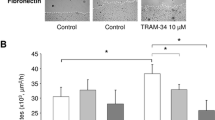Abstract
Integrin beta 4 (ITGB4) is a structural adhesion molecule which engages in maintaining the integrity of airway epithelial cells. Its specific cytomembrane structural feature strongly indicates that ITGB4 may engage in many signaling pathways and physiologic processes. However, in addition to adhesion, the specific biologic significance of ITGB4 in airway epithelial cells is almost unknown. In this article, we investigated the expression and functional properties of ITGB4 in airway epithelial cells in vivo and in vitro. Human bronchial epithelial cell line (16HBE14O-cells) and primary rat tracheal epithelial cells (RTE cells) were used to determine ITGB4 expression under ozone tress or mechanical damage, respectively. An ovalbumin (OVA)-challenged asthma model was used to investigate ITGB4 expression after antigen exposure in vivo. In addition, an ITGB4 overexpression vector and ITGB4 silence virus vector were constructed and transfected into RTE cells. Then, wound repair ability and anti-oxidation capacity was evaluated. Our results demonstrated that, on the edge of mechanically wounded cell areas, ITGB4 expression was increased after mechanical injury. After ozone stress, upregulation expression of ITGB4 was also detected. In the OVA-challenged asthma model, ITGB4 expression was decreased on airway epithelial cells accompanying with structural disruption and damage of anti-oxidation capacity. Besides, our study revealed that upregulation of ITGB4 promotes wound repair ability and anti-oxidative ability, while such abilities were blocked when ITGB4 was silenced. Taken together, these results showed that ITGB4 was a new interesting molecule involved in the regulation of wound repair and anti-oxidation processes for airway epithelial cells.









Similar content being viewed by others
References
Busse W, Elias J, Sheppard D, Banks-Schlegel S (1999) Airway remodeling and repair. Am J Respir Crit Care Med 60:1035–1042
Holgate ST (2007) Epithelium dysfunction in asthma. J Allergy Clin Immunol 120:1233–1244
Hargreave FE, Parameswaran K (2006) Asthma, COPD and bronchitis are just components of airway disease. Eur Respir J 28:264–267
Holgate ST (2007) The epithelium takes centre stage in asthma and atopic dermatitis. Trends Immunol 28:234–251
Bergeron C, Boulet LP (2006) Structural changes in airway diseases characteristics, mechanisms, consequences, and pharmacologic modulation. Chest 129:1068–1087
Trautmann A, Kruger K, Akdis M, Müller-Wening D, Akkaya A, Bröcker EB, Blaser K, Akdis CA (2005) Apoptosis and loss of adhesion of bronchial epithelial cells in asthma. Int Arch Allergy Immunol 138:142–150
Sheeperd D (2003) Functions of pulmonary epithelial integrins: from development to disease. Physiol Rev 83:673–686
Sheppard D (1998) Airway epithelial integrins: why so many? Am J Respir Cell Mol Biol 19:349–351
Mercurio AM, Rabinovitz I, Shaw LM (2001) The α6β4 integrin and epithelial cell migration. Curr Opin Cell Biol 13:541–545
Dowling J, Yu QC, Fuchs E (1996) β4 integrin is required for hemidesmosome formation, cell adhesion and cell survival. J Cell Biol 134:559–572
Davenport EA, Nettesheim P (1996) Regulation of mucociliary differentiation of rat tracheal epithelial cells by type I collagen gel substratum. Am J Respir Cell Mol Biol 14:19–26
Matsuura S, Shirakami G, Iida H, Tanimoto K, Fukuda K (2006) Tracheal epithelial cells: a comparison with isoflurane and halothane. Anesth Analg 102:1703–1708
Qin XQ, Xiang Y (2000) Fibronectin or RGD peptide promotes nitric oxide synthesis of rabbit bronchial epithelial cells. Acta Physiol Sin 52:519–521
Sakon S, Xue X, Takekawa M, Sasazuki T, Okazaki T, Kojima Y, Piao JH, Yagita H (2003) NF-B inhibits TNF-induced accumulation of ROS that mediate prolonged MAPK activation and necrotic cell death. EMBO J 22:3898–3909
Tan YR, Qi MM, Qin XQ, Xiang Y, Li X, Wang Y, Qu F, Liu HJ, Zhang JS (2006) Wound repair and proliferation of bronchial epithelial cells enhanced by bombesinreceptor subtype 3 activation. Peptides 27:1852–1858
Parks WC, Wilson CL, Lopez-Boado YS (2004) Matrix metalloproteinases as modulators of inflammation and innate immunity. Nat Rev Immunol 4:617–629
Hackett TL, Knight DA (2007) The role of epithelial injury and repair in the origins of asthma. Curr Opin Allergy Clin Immunol 7:63–68
Rousselle P, Lunstrum GP, Keene DR, Burgeson RE (1991) Kalinin: an epithelium-specific basement membrane adhesion molecule that is a component of anchoring filaments. J Cell Biol 114:567–576
Tesfaigzi Y (2003) Processes involved in the repair of injured airway epithelia. Arch Immunol Ther Exp 51:283–288
Rahman I, Biswas SK, Kode A (2006) Oxidant and antioxidant balance in the airways and airway diseases. Eur J Pharmacol 533:222–239
Mak JC, Chan-Yeung MM, Moira MW (2006) Reactive oxidant species in asthma. Curr Opin Pulm Med 12:7–11
Bucchieri F, Lordan J, Richter A, Buchanan D (2000) Increased sensitivity of asthmatic bronchial epithelial cells to oxidant-induced injury. Am J Respir Crit Care Med 161:A153
Wu H, Guan C, Qin XQ, Xiang Y, Qi MM, Luo ZQ, Zhang CQ (2007) Upregulation of substance P receptor expression by calcitonin gene-related peptide, a possible cooperative action of two neuropeptides involved in airway inflammation. Pulm Pharmacol Ther 20:513–524
Larivee P, Levine SJ, Martinez A, Logun C, Shelhamer JH (1993) Protein kinase C 4 (zeta) isozyme mediates the airway mucin secretory effect of platelet activating factor. Am Rev Respir Dis 147:A934
Cantin PA (1999) Oxidant and antioxidants in lung injury. In: Moss J (ed) Lam and other diseases characterized by smooth muscle proliferation. Dekker, New York, pp 519–531
Acknowledgments
The authors sincerely appreciate the editor and reviewers for their positive and insightful comments. We thank Professor Gruenert from the San Francisco Branch Campus of the University of California for the gift of the immortalized human bronchial epithelial cell line, 16HBE14O. This study was supported by grant #30800504 from the National Natural Science Foundation of China, the key projects #2007FJ3009 from Hunan Science and Technology plans, and the construct program of the key discipline in Hunan province.
Author information
Authors and Affiliations
Corresponding author
Rights and permissions
About this article
Cite this article
Liu, C., Liu, Hj., Xiang, Y. et al. Wound repair and anti-oxidative capacity is regulated by ITGB4 in airway epithelial cells. Mol Cell Biochem 341, 259–269 (2010). https://doi.org/10.1007/s11010-010-0457-y
Received:
Accepted:
Published:
Issue Date:
DOI: https://doi.org/10.1007/s11010-010-0457-y




